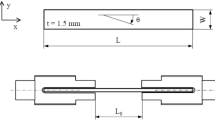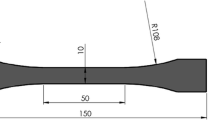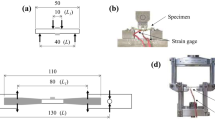Abstract
Experimental flexural tests are conducted on an epoxy oversized 1×6 strand; the objectives of these tests are to measure the bending stiffness and the associated strains. Three sets of boundary conditions are applied. The bending stiffness is deduced from the transverse midspan deflection and is found to be dependent on the axial force and the moment distribution. The deduced bending stiffness is compared to values computed from the theoretical bending stiffnesses.
Similar content being viewed by others
Abbreviations
- a :
-
distance between strand midpoint and transverse loadF t/2
- d c :
-
core diameter (2r c)
- d w :
-
wire diameter (2r w)
- E :
-
Young's modulus
- F t :
-
total cross load
- F z :
-
axial force
- I :
-
bending inertia
- k :
-
(F z/EI)0,5
- K :
-
slippage coefficient
- K ɛ :
-
slippage coefficient used in Ref. 13
- L s :
-
assumed half-length of strand with the simply supported ends bending case, half-distance between rotation axis
- L e :
-
half-length of strand with the fixed ends bending case, half-distance between strand grips
- M :
-
bending moment
- n :
-
number of the wires in a layer
- p :
-
helical pitch
- r :
-
helical radius of the layer of wires in the strand (r c+rw)
- Y A :
-
transverse deflection of strand at midspan
- Z :
-
longitudinal position from strand midpoint
- θ:
-
helical angle
- ɛĵ:
-
tangential strain at the extreme position of the cross section of the strand from the neutral bending plane
- λ:
-
nondimensional parameter
- μ s :
-
static friction coefficient
References
Knapp, R.H., “Simple Bending Models for Helically Armored Cables,” Proc. 2nd Int. Offshore Mechanics and Arctic Eng. Symp., ASME, 360–364 (1983).
Costello, G.A., “Theory of Wire Rope,” Springer-Verlag (1990).
Costello, G.A., “Large Deflections of Helical Spring Due to Bending,”J. Eng. Mech. Div., Proc. ASCE,103, (EM3),481–487 (June1977).
Costello, G.A., “Stresses in Multilayered Cables,” Proc. 2nd Int. Offshore Mechanics and Arctic Eng., ASME, 355–359 (1983).
Lanteigne, J., “Theoretical Estimation of the Response of Helically Armored Cables to Tension, Torsion, Bending,” J. Appl. Mech., 85-APM-13, 1–10 (1985).
Lutchansky, M., “Axial Stresses in Armor Wires of Bent Submarine Cables,” Trans. ASME, J. Eng. for Industry, 687–693 (Aug. 1969).
Raoof, M. andHobbs, R.E., “The Bending of Spiral Strand and Armored Cables Close to Terminations,”J. Energy Resources Tech.,106,349–355 (Sept.1984).
Raoof, M., “Free Bending of Spiral Strands,”J. Eng. Mech.,116, (3),512–530 (March1990).
Vinogradov, O.G. andAtatekin, I.S., “Internal Friction Due to Twist in Bent Cable,”ASCE Trans., J. Eng. Mech.,112, (9),859–873 (Sept.1986).
Sathikh, S. and Parthasarathy N.S., “Effect on Contact Friction on Bending Stiffness and Slip Damping of Stranded Cable,” Proc. Nat. Conf. on Industrial Tribology-89, Indian Space Research Organisation (ISRO), Trivandum 695022, India, 1.11.1-11.6 (Jan. 19–20, 1989).
Parthasarathy, N.S. and Sathikh, S., “Effective Bending Stiffness and Slip Damping of Stranded Cable,” paper sent for presentation to XVII Int. Cong. for Theor, and Appl. Mech., Institut Mecanique De Grenoble, France (Aug. 1988).
Scanlan, R.H. and Swart, R.L., “Bending Stiffness and Strain in Stranded Cables,” IEEE Winter Power Mtg., New York, 1–9 (Jan 1968).
Claren R. andDiana, G., “Dynamic Strain Distribution on Loaded Stranded Cables,”IEEE Trans. on Power Apparatus and Systems, Pas-88,1678–1688, (Nov.1969).
Poffenberger, J.C. andSwart, R.L., “Differential Displacement and Dynamic conductor Strain,”IEEE Trans. Power Apparatus and Systems, PAS-84,281–289 (Apr.1965).
McConnell, K.G. and Zemke, W.P., “The Measurement of Flexural Stiffness of Multistranded Electrical Conductors While Under Tension,” Experimental Mechanics,198–204 (June 1980).
Yu, Ai-Ting, “Vibration Damping of Stranded Cable,”Proc. Soc. for Exp. Stress Analysis,9,141–158 (1952).
Raoof, M., “Free Bending Tests on Large Spiral Strands,” Proc. Inst. Civ. Eng., Part 2, 605–626 (Dec. 1989).
Durelli, A.J. andMachida, S., “Response of Epoxy Oversized Models of Strands to Axial and Torsional Loads,”Experimental Mechanics,13,313–321 (1973).
Roark, R.J. and Young, W.C., Formulas for Stress and Strain, 5th Ed., McGraw Hill, 167–169.
Leclair, R.A., Costello, G.A., “Axial, Bending, and Torsional Loading of a Strand With Friction,”J. of Offshore Mechanics and Arctic Engineering, ASME Trans.,110,38–42 (Feb.1988).
Author information
Authors and Affiliations
Rights and permissions
About this article
Cite this article
Goudreau, S., Cardou, A. Flexural testing of an epoxy oversized strand model under traction. Experimental Mechanics 33, 300–307 (1993). https://doi.org/10.1007/BF02322145
Received:
Revised:
Issue Date:
DOI: https://doi.org/10.1007/BF02322145




